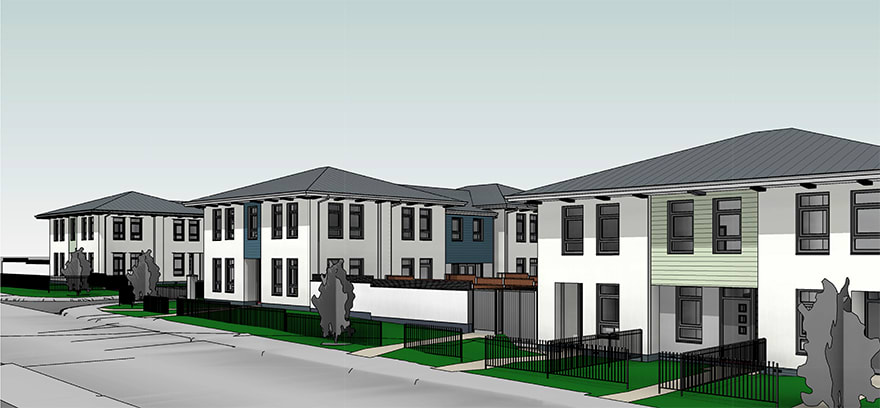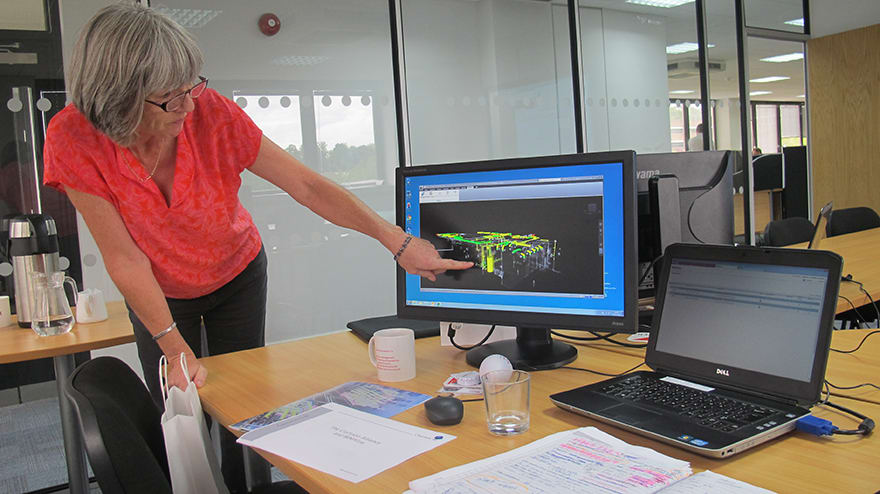- Client: Social housing provider Worthing Homes
- Lead Contractor: The Clarkson Alliance (consultant)
- BIM Tools: Clearbox BIMXtra for the federated BIM model
Meadow Road is a design and build scheme for 12 flats in three blocks, and host to a reseach project funded by Innovate UK (formerly the Technology Strategy Board) to understand the changes in the process and behaviours that construction teams will need to adapt to to work in a “Level 2 BIM environment”.
The research project is being led by the Clarkson Alliance, working alongside software partner Clearbox, a technology start-up partly backed by investment from contractor Kier, main contractor PMC Construction, structural engineer HOP and designer ECE Architecture.
Construction work has not yet begun, but the the tendering process and integrated design via a federated BIM model, run on Clearbox’s central digital information ‘middleware’ platform BIMXtra, has already provided some interesting insights.
An early focus was on developing a BIM Protocol and an Asset Information Model required by the client to effectively operate and maintain the finished building. To achieve this, Worthing Homes put together a set of Employer’s Information Requirements (EIR) based on PAS 1192-2:2013, the Publically Available Standard [PAS] for BIM projects.
PAS 1192-2 is intended as a “one size fits all” standard for projects. However, the approach it lays out needed to be substantially tailored to fit the needs of this smaller project, where there were far fewer people and less data than would be typical in a major government scheme.
“PAS 1192-2 is a very difficult document to read, I’ve heard SMEs use words like ‘impenetrable’,” acknowledges Julian Bullen, project director at the Clarkson Alliance. “However, it provided us with a framework to work within, we selected the parts relevant to us and translated them into our own documentation to make it more accessible and easy to read.
“We found it vital to use PAS terminology consistently, so that everyone is speaking in a common language, for example they know the difference between a BIM Information Manager and a BIM Coordinator and their responsibilities.”
Where the PAS assumes a single stage tender process, Meadow Road went through a two-stage process.
The first stage saw the design developed in 2D CAD and tendered in the traditional manner. After contractor PMC Construction and the full design team was appointed, the BIM Execution Plan and related assessments were then carried out before developing the design and moving on to the second stage tender.


A federated BIM model, run on Clearbox’s central ‘middleware’ platform BimXtra, has already provided some interesting insights
BIM’s powerful 3D visualisations and ability to carry out clash detection to quickly resolve design issues meant there was far less inherent design risk for contractor PMC compared to a traditional design and build contract, so the contract was apparently priced minus the normal risk premium.
Several software tools are being used by the project team and supply chain. Data originated in Autodesk Revit which interfaces with BIMXtra, a cloud-based data hub that consolidates the information and coordinates the construction schedule, cost planning, asset information as well as other functions.
BIMXtra is currently used by Kier’s construction businesses, and has performed well. However, some members of the project have been reluctant or unable to engage with it, says Bullen: “The architect, contractor, M&E and engineer understand it, but it is when you go down to the next level, to the timber frame and windows suppliers etc. some of those people haven’t entered that world yet.”
One issue has been insufficient access to reliable BIM object data on products from certain manufacturers and suppliers, which has forced the designers to draw up the objects themselves from scratch. BIMXtra has nevertheless helped to expose the maturity of the BIM information and helped many in the team avoid the complexity of the traditional BIM authoring tools.
It turns out that products initially specified by the architect, and their attendant BIM objects, were abandoned by the contractor during detailed design in favour of cheaper or higher quality alternatives, which sometimes lacked BIM object data.
“We have been through four different windows suppliers and the current one doesn’t have windows available as BIM objects. It means we lose the advantage of having that level of detail in model and being able to see how it interfaces with other components,” says Bullen.
“There’s a massive push to get manufacturers to update their BIM libraries, the penny is dropping with many of them, but if you’re a small window manufacturer just coming out of the recession you may not have all of your products in CAD yet, let alone BIM software.”
This also raised concerns in relation to contractual responsibility and BIM information: with the windows, for instance, the contractor is providing a component that is compliant with the employer’s specification requirements, but not necessarily with its EIR information requirements.
“This is where someone has to make a judgement call in terms of whether they have complied with the contract because they haven’t provided the BIM information component when it was available, albeit for an alternative product,” says Bullen.
Although the technology has created some headaches, the biggest challenges have related to behavioural and cultural changes needed to work collaboratively in a BIM environment. In addition to regular training in BIMXtra, the Innovate UK funding is being used to run several workshops and analysis on behavioural change.
“The biggest challenge is not the tools and processes, but the people. Individuals need to have a level of trust and confidence in one another to work collaboratively using BIM as well as embrace technological change. You have to work very hard to win people over to the concept of change being a good thing, neuroscience shows us that brains are pre-wired to go into flight, fight or freeze mode when confronted by things they are not familiar with. We’ve had to work very hard to win people over to the concept of change being a good thing, ” concludes Bullen.

We found it vital to use PAS terminology consistently, so that everyone is speaking in a common language, for example they know the difference between a BIM Information Manager and a BIM Coordinator and their responsibilities.– Julian Bullen, Clarkson Alliance











